Mariposa Native Plants Blog
May 4-5, 2019: Mariposa Butterfly Festival
 Mariposa Native Plants was present at the Butterfly Festival in Mariposa. Many of the festival visitors
were not aware of the close relationship between the monarch butterfly and the milkweeds in the Asclepias
genus. We sold over 30 milkweeds, including A.fascicularis, A.speciosa, and A.eriocarpa, as
well as a number of other California native plants.
Mariposa Native Plants was present at the Butterfly Festival in Mariposa. Many of the festival visitors
were not aware of the close relationship between the monarch butterfly and the milkweeds in the Asclepias
genus. We sold over 30 milkweeds, including A.fascicularis, A.speciosa, and A.eriocarpa, as
well as a number of other California native plants.
June 22-23, 2019: Monarchs and Milkweeds public workshop presentation
 Ron Allen (IT Manager, Mariposa Native Plants and UC Master Gardener, Mariposa County) and Ted Barnecut (UC
Master Gardener, Sutter County) presented a public workshop sponsored by the UC Master Gardeners on Monarchs
and Milkweeds on June 22nd at the Board of Supervisors chambers in Mariposa. The next day, we went on a
milkweed survey in southern Mariposa and nearby Madera Counties. The photo shows Ron & Ted next to a large
patch of Showy Milkweed, A.speciosa, along Tip Top Road in Mariposa.
Ron Allen (IT Manager, Mariposa Native Plants and UC Master Gardener, Mariposa County) and Ted Barnecut (UC
Master Gardener, Sutter County) presented a public workshop sponsored by the UC Master Gardeners on Monarchs
and Milkweeds on June 22nd at the Board of Supervisors chambers in Mariposa. The next day, we went on a
milkweed survey in southern Mariposa and nearby Madera Counties. The photo shows Ron & Ted next to a large
patch of Showy Milkweed, A.speciosa, along Tip Top Road in Mariposa.
August 10, 2019: Planting initial milkweed plot at Heather & Dave's ranch in Hornitos
Ron & Bev brought 10 milkweeds (6 A.fascicularis, 2 A.speciosa, and 2 A.eriocarpa) out
to Hornitos and helped Heather put them in the ground. Later we found out that the gopher screens we put in
the ground with them were inadequate, and several plants were eaten. We now realize that a mesh with holes
no larger than 1/2 inch is required.
September 22, 2019: Mariposa Native Plants appears on the Calscape website
MNP is now listed among the native plant nurseries on the Calscape website: Calscape (CNPS).
October 23, 2019: Pacific Blackberry!
 OMG! I was hiking over the southern portion of Mariposa Native Plant's cultivation area near Midpines Summit,
about 6 miles east of Mariposa, checking on the tree pruning operation that taken place in the last few days.
At the bottom of an ephemeral stream course, I stumbled upon a number of Pacific Blackberry (Rubus ursinus)
vines! Around Mariposa, one typically finds a lot of Himalayan Blackberry (Rubus armeniacus) infestations, but
this invasive plant can be distinguished from our native blackberry by its having more than 3 leaflets and its
evergreen growth habit. Native blackberry vines always have exactly 3 leaflets, as in the photo, and they are
winter deciduous. We will be trying to cultivate this native blackberry in the coming months. Stay tuned.
OMG! I was hiking over the southern portion of Mariposa Native Plant's cultivation area near Midpines Summit,
about 6 miles east of Mariposa, checking on the tree pruning operation that taken place in the last few days.
At the bottom of an ephemeral stream course, I stumbled upon a number of Pacific Blackberry (Rubus ursinus)
vines! Around Mariposa, one typically finds a lot of Himalayan Blackberry (Rubus armeniacus) infestations, but
this invasive plant can be distinguished from our native blackberry by its having more than 3 leaflets and its
evergreen growth habit. Native blackberry vines always have exactly 3 leaflets, as in the photo, and they are
winter deciduous. We will be trying to cultivate this native blackberry in the coming months. Stay tuned.
November 22, 2019: CalFire's Kuldeep Singh visits Mariposa Native Plants
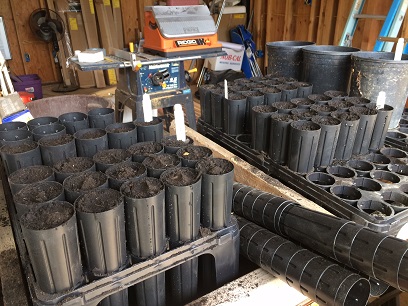 Kuldeep is the Horticulturist and Nursery Manager at CalFire's L.A. Moran Reforestation Center in Davis, CA.
He came to visit MNP at our cultivation location in Mariposa to learn the finer points of propagating Canyon
Live Oak (Quercus chrysolepis) from acorns. MNP IT Manager Ron Allen met with Kuldeep, showed where and
how we gather Q.chrysolepis acorns, reviewed the stratification process, explained how to gauge the health
of an acorn, and showed how they are started in propagation deeppots (photo at right).
Kuldeep is the Horticulturist and Nursery Manager at CalFire's L.A. Moran Reforestation Center in Davis, CA.
He came to visit MNP at our cultivation location in Mariposa to learn the finer points of propagating Canyon
Live Oak (Quercus chrysolepis) from acorns. MNP IT Manager Ron Allen met with Kuldeep, showed where and
how we gather Q.chrysolepis acorns, reviewed the stratification process, explained how to gauge the health
of an acorn, and showed how they are started in propagation deeppots (photo at right).
December 16, 2019: Mariposa Native Plants buys a label printer
 MNP purchased a commercial quality Datamax-O'Neil label printer. We've begun printing out pot labels and using
them to organize our inventory. It took a bit of fussing with the printer to get it to work, because, as it
turned out I (RLA) had the printer ribbon installed backwards on the machine. OK, well, there were no instructions
in the install kit about which type of ribbon I was working with, nor were there any instructions about how to
determine the type of ribbon in my hand, but...in the end, by trial and error, we began to crank out the damn
pot labels. I thought about having a cute butterfly logo on the label. But, I thought that it was more important
to have print type as large as possible--and so to remain legible on the pot stake while subject to weathering--
and yet contain the very basic, minimal information that a buyer would need in order to locate and grow the plant.
So, that's why our plant stakes are a bit more stark and glib than others you might encounter.
MNP purchased a commercial quality Datamax-O'Neil label printer. We've begun printing out pot labels and using
them to organize our inventory. It took a bit of fussing with the printer to get it to work, because, as it
turned out I (RLA) had the printer ribbon installed backwards on the machine. OK, well, there were no instructions
in the install kit about which type of ribbon I was working with, nor were there any instructions about how to
determine the type of ribbon in my hand, but...in the end, by trial and error, we began to crank out the damn
pot labels. I thought about having a cute butterfly logo on the label. But, I thought that it was more important
to have print type as large as possible--and so to remain legible on the pot stake while subject to weathering--
and yet contain the very basic, minimal information that a buyer would need in order to locate and grow the plant.
So, that's why our plant stakes are a bit more stark and glib than others you might encounter.
December 26, 2019: Holiday gift of acorns
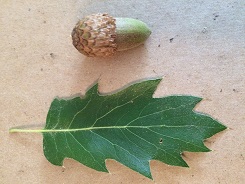 From Greg and Michalene in Bootjack, MNP received the holiday gift of a batch of acorns from the Oracle Oak on
their property. The Oracle Oak is a natural hybrid of Black Oak, Quercus kelloggii, and Interior Live Oak,
Quercus wislizeni. The odd thing about this tree is that it's physical characteristics seem to lie almost
perfectly in the middle of the tree characteristics of its parent plants. It is semi-deciduous, dropping only
some of its leaves in the winter. (The Black Oak is deciduous, but the Interior Live Oak is wintergreen.)
It has a leaf that is not as wide and not as deeply-lobed as the Black Oak, but still has the spines and the
narrow, elongated aspect of the Interior Live Oak leaves. The acorn is not as barrel-shaped as the Black Oak's,
but they are not long and thin like the Interior Live's. It's really an attractive oak tree. We will attempt to
propagate this specimen from acorns. The acorns are currently in stratification. As a side note, there is an
Oracle Oak on MNP's property in Bootjack as well, but it did not produce substantial acorns this year.
From Greg and Michalene in Bootjack, MNP received the holiday gift of a batch of acorns from the Oracle Oak on
their property. The Oracle Oak is a natural hybrid of Black Oak, Quercus kelloggii, and Interior Live Oak,
Quercus wislizeni. The odd thing about this tree is that it's physical characteristics seem to lie almost
perfectly in the middle of the tree characteristics of its parent plants. It is semi-deciduous, dropping only
some of its leaves in the winter. (The Black Oak is deciduous, but the Interior Live Oak is wintergreen.)
It has a leaf that is not as wide and not as deeply-lobed as the Black Oak, but still has the spines and the
narrow, elongated aspect of the Interior Live Oak leaves. The acorn is not as barrel-shaped as the Black Oak's,
but they are not long and thin like the Interior Live's. It's really an attractive oak tree. We will attempt to
propagate this specimen from acorns. The acorns are currently in stratification. As a side note, there is an
Oracle Oak on MNP's property in Bootjack as well, but it did not produce substantial acorns this year.
January 11, 2020: Hite's Cove trail hike and plant collection
 Mariposa Native Plants and UC Master Gardener Ron Allen were invited to pull plants from the Hite's Cove Trail
above the South Fork of the Merced River on January 11, 2020. I (RLA) accompanied Bill King and his trail crew,
only removing plants that intruded onto the established trail. Bill works with a volunteer crew of trail maintainers
under the auspices of the US Forest Service (USFS). After the Briceburg Fire, the trail is closed to the public, but
Bill and his crew have permission from the USFS and local land owners to enter onto the trail and perform
maintenance work. I was able to collect about two dozen small Ceanothus tomentosus (Woollyleaf
Ceanothus) plants that had grown into the trail. Here are my bags and backpack about to head back to Highway
140 (right). I had anticipated that I might fill the shopping bag there as well, but since the trail turned out
to be quite precipitous, I decided that a free right hand was the way to return to my truck. Overall, it was a great
morning. Within Bill's crew were Marty, Dave, Connie, Jack, and Ralph, as well as myself. Ralph Mendershausen gave
a great talk to our group, right at the place where I gathered plants. He covered the history of Hite's Cove, from
the time that the Native Americans fished the Merced River for salmon and crushed acorns into meal in the rocks
right behind us, to when Hite developed a productive gold mine further up river, and then to when Chinese workers
built a sluice works and brought in a stamping mill over from Jerseydale to crush quartz and extract gold ore in the
19th century.
Mariposa Native Plants and UC Master Gardener Ron Allen were invited to pull plants from the Hite's Cove Trail
above the South Fork of the Merced River on January 11, 2020. I (RLA) accompanied Bill King and his trail crew,
only removing plants that intruded onto the established trail. Bill works with a volunteer crew of trail maintainers
under the auspices of the US Forest Service (USFS). After the Briceburg Fire, the trail is closed to the public, but
Bill and his crew have permission from the USFS and local land owners to enter onto the trail and perform
maintenance work. I was able to collect about two dozen small Ceanothus tomentosus (Woollyleaf
Ceanothus) plants that had grown into the trail. Here are my bags and backpack about to head back to Highway
140 (right). I had anticipated that I might fill the shopping bag there as well, but since the trail turned out
to be quite precipitous, I decided that a free right hand was the way to return to my truck. Overall, it was a great
morning. Within Bill's crew were Marty, Dave, Connie, Jack, and Ralph, as well as myself. Ralph Mendershausen gave
a great talk to our group, right at the place where I gathered plants. He covered the history of Hite's Cove, from
the time that the Native Americans fished the Merced River for salmon and crushed acorns into meal in the rocks
right behind us, to when Hite developed a productive gold mine further up river, and then to when Chinese workers
built a sluice works and brought in a stamping mill over from Jerseydale to crush quartz and extract gold ore in the
19th century.
June 17, 2020: Mariposa Farmer's Market
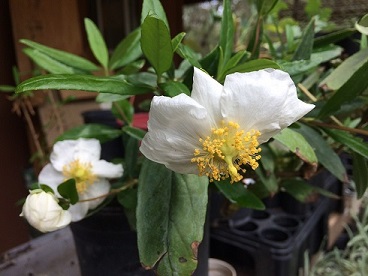 Mariposa Native Plants set up a booth and tables at the Mariposa Farmer's Market, 6th and Jessie Streets in
Mariposa, California. We sold out of the Narrowleaf Milkweed that we brought for sale. We sold a variety of
far more attractive native plants, such as the Bush Anemone (Carpenteria californica), or just
Carpenteria, shown here.
Carpenteria is a widely available nursery plant, having been propagated from its origins just east of Fresno
in the Sierra foothills. It is an evergree shrub, and it is well-adapted to the Sierra foothills.
Mariposa Native Plants set up a booth and tables at the Mariposa Farmer's Market, 6th and Jessie Streets in
Mariposa, California. We sold out of the Narrowleaf Milkweed that we brought for sale. We sold a variety of
far more attractive native plants, such as the Bush Anemone (Carpenteria californica), or just
Carpenteria, shown here.
Carpenteria is a widely available nursery plant, having been propagated from its origins just east of Fresno
in the Sierra foothills. It is an evergree shrub, and it is well-adapted to the Sierra foothills.
August 3, 2020: Mystery seeds in the mail
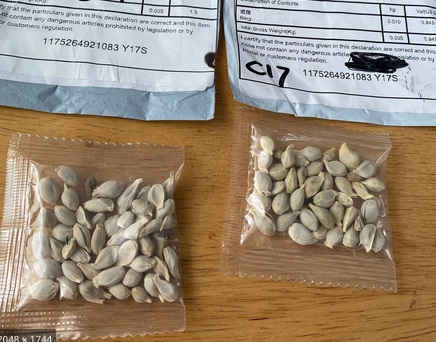 A number of people across the United States have been receiving some complimentary seed packages from China.
DO NOT OPEN THE PLACKAGE, AND DO NOT PLANT THEM. As far as has been determined, the seeds are not harmful, but
one should not plant seeds that come from an unknown source. If you receive them, you should not open the
package, and you should send the packet to your local Agricultural Inspector's office.
A number of people across the United States have been receiving some complimentary seed packages from China.
DO NOT OPEN THE PLACKAGE, AND DO NOT PLANT THEM. As far as has been determined, the seeds are not harmful, but
one should not plant seeds that come from an unknown source. If you receive them, you should not open the
package, and you should send the packet to your local Agricultural Inspector's office.
April 11, 2021: Asclepias erosa seedlings
 MNP customer Ryan G in Wrightwood, CA, sent this photo of his Asclepias erosa seedlings. Commonly known
as Desert Milkweed, A.erosa grows in the Mojave Desert region of Southern California, into Arizona, and
south into Baja California. Once they are nice and tall, the plan is to plant them out in the desert in order
to provide further habitat for the Monarch Butterfly caterpillars.
We don't carry this plant at MNP. It does grow in the area around Bakersfield, however, and even as far north
as Visalia, CA. I wonder if it's worth investigating for planting in the Sierra foothills.
MNP customer Ryan G in Wrightwood, CA, sent this photo of his Asclepias erosa seedlings. Commonly known
as Desert Milkweed, A.erosa grows in the Mojave Desert region of Southern California, into Arizona, and
south into Baja California. Once they are nice and tall, the plan is to plant them out in the desert in order
to provide further habitat for the Monarch Butterfly caterpillars.
We don't carry this plant at MNP. It does grow in the area around Bakersfield, however, and even as far north
as Visalia, CA. I wonder if it's worth investigating for planting in the Sierra foothills.
July 3-4, 2021: Mariposa Butterfly Festival
MNP had a booth in the Habitat Row at the Butterfly Festival this last 4th of July weekend. The festival was very
well attended. In fact, although it wasn't supposed to open until noon on the 3rd, people swarmed into the fairgrounds
starting around 10am. We were setting up the booth and unloading plants while people were asking questions and trying
to buy a plant. Overall, we talked to a lot of people about native plant landscaping and sold over 40 plants.
August 1, 2021: Asclepias vestita seeds
Our collection of roadside Woolly Milkweed seeds in Mariposa and Madera Counties was less than spectacular this
year. We have a limited supply of seeds for Asclepias vestita, and we will be limiting the volumes of
seeds that we sell to individual customers. It's also unfortunate that the recent River Fire in southern Mariposa
and eastern Madera Counties destroyed a lot of the Woolly Milkweed habitat. We were able to verify that many of
our most reliable seed source plants were outside the main burn area, although some had been run over by fire
equipment.
August 25, 2021: Coyote Mint (Monardella villosa) seeds
We have collected a bit more Coyote Mint seeds this summer. The seeds do not need any special treatment; you can
just plant them directly into germination containers. We recommend that you sprinkle a few of the seed husks into
an individual container. If multiple sprouts arise, then cultivate them for a few weeks and clip off the weaker
ones to ensure a single Monardella villosa in a single germination cup. Keep the planted seeds moist, and
when they begin to sprout, move them gradually into brighter sunlight.
August 26, 2021: Interviewed!
MNP owners Bev & Ron were interviewed by our local newspaper, the Mariposa Gazette.
September 28, 2021: Meeting with Sunburst Nurseries
MNP IT Manager Ron Allen met with Jim Reed and Rick Lafferty of Sunburst Nurseries of Porterville, CA. Rick and Jim were
investigating the cultivation of native California milkweeds.
October 5, 2021: Conversation with California Department of Fish and Game
MNP IT Manager Ron Allen discussed milkweeds and monarchs with Diana Magor of the California Department of Fish and Wildlife.
Diana was interested in our cultivation techniques at Mariposa Native Plants, how well the various Asclepias genus
milkweeds provide predator prevention through the uptake of cardiac glycocide toxins into the monarch butterfly caterpillars,
and, finally, and how well the plants do in terms of herbivore management.
October 20, 2021: Last Mariposa Farmer's Market of the Year
MNP ended a very successful season at the Mariposa Farmer's Market. We met quite a few new people, helped out many new
customers, and more than doubled our sales compared to 2020. We will be on vacation from the end of October through the
first two weeks of November.
November 17, 2021: Native Plant Garden at Mariposa History Center
MNP provided plants for the Mariposa History Center, a project establishing a native plant demonstration garden in the front yard
of the museum. The selection of plants was provided by the local Southern Sierra Miwok Nation, based on plants that the tribe used
historically. About two dozen local community folks came to help with planting, including History Center staff, UC Master Gardeners from
Mariposa County, the Southern Sierra Miwok Nation, school children from the Sierra Foothills Charter School, and Mariposa Native Plants.
We dropped about 50 plants into the ground, and we were done in two hours (thanks to the numerous helpers armed with shovels!).
November 29, 2021: Heartleaf Milkweed Survey of Southern Mariposa and Eastern Madera Counties
MNP IT Manager Ron Allen toured southern Mariposa County and eastern Madera County with Diana Magor of the California Department
of Fish and Wildlife. Diana was interested in the growth habits of local Heartleaf Milkweed (Asclepias cordifolia), the soil
types in which this plant grows, and how large the plants can grow.
December 31, 2021: Sold out: Heartleaf, California, and Woolly Milkweed seeds
We have sold out our stock of seeds for these popular plants. Due to the drought and the River Fire in southern Mariposa and eastern
Madera Counties in 2021, our seed collection was rather poor. We have had some good, wet weather so far in the month of December, and
we're hoping that the local milkweeds will have good follicle production in the summer of 2022.
May 17, 2022: Native plant customers with a helicopter
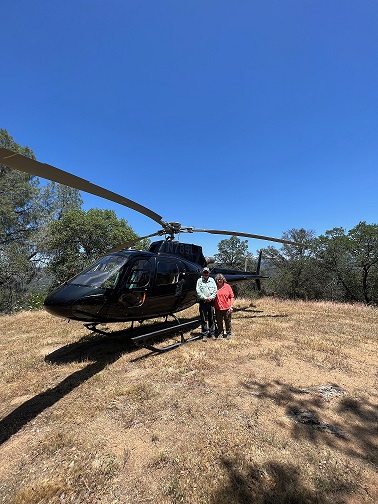 MNP customer Sally wanted to pick up four California Ash trees that she had ordered. The problem for her was that
it was a long drive to Mariposa from the Bay Area. What to do? Sally enlisted her son Peter to fly her to Mariposa
in his helicopter. There is a flat on a hill above our house which the previous owners used for cutting and storing
firewood. We always called it the "helicopter landing pad", but never did we ever think that it might be used
for that very purpose. Here are MNP owners Ron & Bev standing next to the helicopter on the "landing pad".
MNP customer Sally wanted to pick up four California Ash trees that she had ordered. The problem for her was that
it was a long drive to Mariposa from the Bay Area. What to do? Sally enlisted her son Peter to fly her to Mariposa
in his helicopter. There is a flat on a hill above our house which the previous owners used for cutting and storing
firewood. We always called it the "helicopter landing pad", but never did we ever think that it might be used
for that very purpose. Here are MNP owners Ron & Bev standing next to the helicopter on the "landing pad".
October 4, 2022: Another flying customer for Mariposa Native Plants
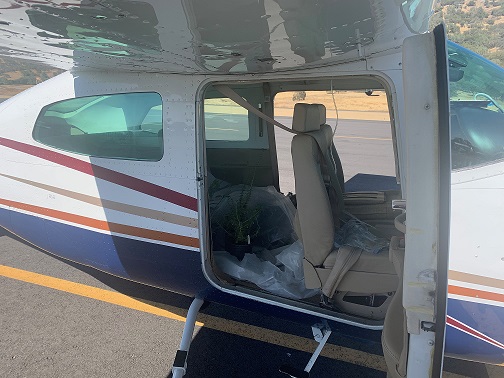 We had a couple of visits from Bay Area resident Les to MNP. We met Les in early October at the Mariposa-Yosemite Airport,
north of town on Highway 49. We loaded up his Cessna with the plants right behind the front seats, but I (RA) mixed up
the plants, and Les was short a couple of Chokecherry trees he ordered. He flew in again on October 14 for more plants
and to fill out the Prunus virginiana plants that should have been loaded on the plane a fortnight earlier.
Here's Les's Cessna 210 at the Mariposa Airport with plants loaded in the back, sitting on plastic sheet. It's a little
dark in there, but it's a good load.
We had a couple of visits from Bay Area resident Les to MNP. We met Les in early October at the Mariposa-Yosemite Airport,
north of town on Highway 49. We loaded up his Cessna with the plants right behind the front seats, but I (RA) mixed up
the plants, and Les was short a couple of Chokecherry trees he ordered. He flew in again on October 14 for more plants
and to fill out the Prunus virginiana plants that should have been loaded on the plane a fortnight earlier.
Here's Les's Cessna 210 at the Mariposa Airport with plants loaded in the back, sitting on plastic sheet. It's a little
dark in there, but it's a good load.
 Mariposa Native Plants was present at the Butterfly Festival in Mariposa. Many of the festival visitors
were not aware of the close relationship between the monarch butterfly and the milkweeds in the Asclepias
genus. We sold over 30 milkweeds, including A.fascicularis, A.speciosa, and A.eriocarpa, as
well as a number of other California native plants.
Mariposa Native Plants was present at the Butterfly Festival in Mariposa. Many of the festival visitors
were not aware of the close relationship between the monarch butterfly and the milkweeds in the Asclepias
genus. We sold over 30 milkweeds, including A.fascicularis, A.speciosa, and A.eriocarpa, as
well as a number of other California native plants.
 Ron Allen (IT Manager, Mariposa Native Plants and UC Master Gardener, Mariposa County) and Ted Barnecut (UC
Master Gardener, Sutter County) presented a public workshop sponsored by the UC Master Gardeners on Monarchs
and Milkweeds on June 22nd at the Board of Supervisors chambers in Mariposa. The next day, we went on a
milkweed survey in southern Mariposa and nearby Madera Counties. The photo shows Ron & Ted next to a large
patch of Showy Milkweed, A.speciosa, along Tip Top Road in Mariposa.
Ron Allen (IT Manager, Mariposa Native Plants and UC Master Gardener, Mariposa County) and Ted Barnecut (UC
Master Gardener, Sutter County) presented a public workshop sponsored by the UC Master Gardeners on Monarchs
and Milkweeds on June 22nd at the Board of Supervisors chambers in Mariposa. The next day, we went on a
milkweed survey in southern Mariposa and nearby Madera Counties. The photo shows Ron & Ted next to a large
patch of Showy Milkweed, A.speciosa, along Tip Top Road in Mariposa.
 OMG! I was hiking over the southern portion of Mariposa Native Plant's cultivation area near Midpines Summit,
about 6 miles east of Mariposa, checking on the tree pruning operation that taken place in the last few days.
At the bottom of an ephemeral stream course, I stumbled upon a number of Pacific Blackberry (Rubus ursinus)
vines! Around Mariposa, one typically finds a lot of Himalayan Blackberry (Rubus armeniacus) infestations, but
this invasive plant can be distinguished from our native blackberry by its having more than 3 leaflets and its
evergreen growth habit. Native blackberry vines always have exactly 3 leaflets, as in the photo, and they are
winter deciduous. We will be trying to cultivate this native blackberry in the coming months. Stay tuned.
OMG! I was hiking over the southern portion of Mariposa Native Plant's cultivation area near Midpines Summit,
about 6 miles east of Mariposa, checking on the tree pruning operation that taken place in the last few days.
At the bottom of an ephemeral stream course, I stumbled upon a number of Pacific Blackberry (Rubus ursinus)
vines! Around Mariposa, one typically finds a lot of Himalayan Blackberry (Rubus armeniacus) infestations, but
this invasive plant can be distinguished from our native blackberry by its having more than 3 leaflets and its
evergreen growth habit. Native blackberry vines always have exactly 3 leaflets, as in the photo, and they are
winter deciduous. We will be trying to cultivate this native blackberry in the coming months. Stay tuned.
 Kuldeep is the Horticulturist and Nursery Manager at CalFire's L.A. Moran Reforestation Center in Davis, CA.
He came to visit MNP at our cultivation location in Mariposa to learn the finer points of propagating Canyon
Live Oak (Quercus chrysolepis) from acorns. MNP IT Manager Ron Allen met with Kuldeep, showed where and
how we gather Q.chrysolepis acorns, reviewed the stratification process, explained how to gauge the health
of an acorn, and showed how they are started in propagation deeppots (photo at right).
Kuldeep is the Horticulturist and Nursery Manager at CalFire's L.A. Moran Reforestation Center in Davis, CA.
He came to visit MNP at our cultivation location in Mariposa to learn the finer points of propagating Canyon
Live Oak (Quercus chrysolepis) from acorns. MNP IT Manager Ron Allen met with Kuldeep, showed where and
how we gather Q.chrysolepis acorns, reviewed the stratification process, explained how to gauge the health
of an acorn, and showed how they are started in propagation deeppots (photo at right).
 MNP purchased a commercial quality Datamax-O'Neil label printer. We've begun printing out pot labels and using
them to organize our inventory. It took a bit of fussing with the printer to get it to work, because, as it
turned out I (RLA) had the printer ribbon installed backwards on the machine. OK, well, there were no instructions
in the install kit about which type of ribbon I was working with, nor were there any instructions about how to
determine the type of ribbon in my hand, but...in the end, by trial and error, we began to crank out the damn
pot labels. I thought about having a cute butterfly logo on the label. But, I thought that it was more important
to have print type as large as possible--and so to remain legible on the pot stake while subject to weathering--
and yet contain the very basic, minimal information that a buyer would need in order to locate and grow the plant.
So, that's why our plant stakes are a bit more stark and glib than others you might encounter.
MNP purchased a commercial quality Datamax-O'Neil label printer. We've begun printing out pot labels and using
them to organize our inventory. It took a bit of fussing with the printer to get it to work, because, as it
turned out I (RLA) had the printer ribbon installed backwards on the machine. OK, well, there were no instructions
in the install kit about which type of ribbon I was working with, nor were there any instructions about how to
determine the type of ribbon in my hand, but...in the end, by trial and error, we began to crank out the damn
pot labels. I thought about having a cute butterfly logo on the label. But, I thought that it was more important
to have print type as large as possible--and so to remain legible on the pot stake while subject to weathering--
and yet contain the very basic, minimal information that a buyer would need in order to locate and grow the plant.
So, that's why our plant stakes are a bit more stark and glib than others you might encounter.
 From Greg and Michalene in Bootjack, MNP received the holiday gift of a batch of acorns from the Oracle Oak on
their property. The Oracle Oak is a natural hybrid of Black Oak, Quercus kelloggii, and Interior Live Oak,
Quercus wislizeni. The odd thing about this tree is that it's physical characteristics seem to lie almost
perfectly in the middle of the tree characteristics of its parent plants. It is semi-deciduous, dropping only
some of its leaves in the winter. (The Black Oak is deciduous, but the Interior Live Oak is wintergreen.)
It has a leaf that is not as wide and not as deeply-lobed as the Black Oak, but still has the spines and the
narrow, elongated aspect of the Interior Live Oak leaves. The acorn is not as barrel-shaped as the Black Oak's,
but they are not long and thin like the Interior Live's. It's really an attractive oak tree. We will attempt to
propagate this specimen from acorns. The acorns are currently in stratification. As a side note, there is an
Oracle Oak on MNP's property in Bootjack as well, but it did not produce substantial acorns this year.
From Greg and Michalene in Bootjack, MNP received the holiday gift of a batch of acorns from the Oracle Oak on
their property. The Oracle Oak is a natural hybrid of Black Oak, Quercus kelloggii, and Interior Live Oak,
Quercus wislizeni. The odd thing about this tree is that it's physical characteristics seem to lie almost
perfectly in the middle of the tree characteristics of its parent plants. It is semi-deciduous, dropping only
some of its leaves in the winter. (The Black Oak is deciduous, but the Interior Live Oak is wintergreen.)
It has a leaf that is not as wide and not as deeply-lobed as the Black Oak, but still has the spines and the
narrow, elongated aspect of the Interior Live Oak leaves. The acorn is not as barrel-shaped as the Black Oak's,
but they are not long and thin like the Interior Live's. It's really an attractive oak tree. We will attempt to
propagate this specimen from acorns. The acorns are currently in stratification. As a side note, there is an
Oracle Oak on MNP's property in Bootjack as well, but it did not produce substantial acorns this year.
 Mariposa Native Plants and UC Master Gardener Ron Allen were invited to pull plants from the Hite's Cove Trail
above the South Fork of the Merced River on January 11, 2020. I (RLA) accompanied Bill King and his trail crew,
only removing plants that intruded onto the established trail. Bill works with a volunteer crew of trail maintainers
under the auspices of the US Forest Service (USFS). After the Briceburg Fire, the trail is closed to the public, but
Bill and his crew have permission from the USFS and local land owners to enter onto the trail and perform
maintenance work. I was able to collect about two dozen small Ceanothus tomentosus (Woollyleaf
Ceanothus) plants that had grown into the trail. Here are my bags and backpack about to head back to Highway
140 (right). I had anticipated that I might fill the shopping bag there as well, but since the trail turned out
to be quite precipitous, I decided that a free right hand was the way to return to my truck. Overall, it was a great
morning. Within Bill's crew were Marty, Dave, Connie, Jack, and Ralph, as well as myself. Ralph Mendershausen gave
a great talk to our group, right at the place where I gathered plants. He covered the history of Hite's Cove, from
the time that the Native Americans fished the Merced River for salmon and crushed acorns into meal in the rocks
right behind us, to when Hite developed a productive gold mine further up river, and then to when Chinese workers
built a sluice works and brought in a stamping mill over from Jerseydale to crush quartz and extract gold ore in the
19th century.
Mariposa Native Plants and UC Master Gardener Ron Allen were invited to pull plants from the Hite's Cove Trail
above the South Fork of the Merced River on January 11, 2020. I (RLA) accompanied Bill King and his trail crew,
only removing plants that intruded onto the established trail. Bill works with a volunteer crew of trail maintainers
under the auspices of the US Forest Service (USFS). After the Briceburg Fire, the trail is closed to the public, but
Bill and his crew have permission from the USFS and local land owners to enter onto the trail and perform
maintenance work. I was able to collect about two dozen small Ceanothus tomentosus (Woollyleaf
Ceanothus) plants that had grown into the trail. Here are my bags and backpack about to head back to Highway
140 (right). I had anticipated that I might fill the shopping bag there as well, but since the trail turned out
to be quite precipitous, I decided that a free right hand was the way to return to my truck. Overall, it was a great
morning. Within Bill's crew were Marty, Dave, Connie, Jack, and Ralph, as well as myself. Ralph Mendershausen gave
a great talk to our group, right at the place where I gathered plants. He covered the history of Hite's Cove, from
the time that the Native Americans fished the Merced River for salmon and crushed acorns into meal in the rocks
right behind us, to when Hite developed a productive gold mine further up river, and then to when Chinese workers
built a sluice works and brought in a stamping mill over from Jerseydale to crush quartz and extract gold ore in the
19th century.
 Mariposa Native Plants set up a booth and tables at the Mariposa Farmer's Market, 6th and Jessie Streets in
Mariposa, California. We sold out of the Narrowleaf Milkweed that we brought for sale. We sold a variety of
far more attractive native plants, such as the Bush Anemone (Carpenteria californica), or just
Carpenteria, shown here.
Carpenteria is a widely available nursery plant, having been propagated from its origins just east of Fresno
in the Sierra foothills. It is an evergree shrub, and it is well-adapted to the Sierra foothills.
Mariposa Native Plants set up a booth and tables at the Mariposa Farmer's Market, 6th and Jessie Streets in
Mariposa, California. We sold out of the Narrowleaf Milkweed that we brought for sale. We sold a variety of
far more attractive native plants, such as the Bush Anemone (Carpenteria californica), or just
Carpenteria, shown here.
Carpenteria is a widely available nursery plant, having been propagated from its origins just east of Fresno
in the Sierra foothills. It is an evergree shrub, and it is well-adapted to the Sierra foothills.
 A number of people across the United States have been receiving some complimentary seed packages from China.
DO NOT OPEN THE PLACKAGE, AND DO NOT PLANT THEM. As far as has been determined, the seeds are not harmful, but
one should not plant seeds that come from an unknown source. If you receive them, you should not open the
package, and you should send the packet to your local Agricultural Inspector's office.
A number of people across the United States have been receiving some complimentary seed packages from China.
DO NOT OPEN THE PLACKAGE, AND DO NOT PLANT THEM. As far as has been determined, the seeds are not harmful, but
one should not plant seeds that come from an unknown source. If you receive them, you should not open the
package, and you should send the packet to your local Agricultural Inspector's office.
 MNP customer Ryan G in Wrightwood, CA, sent this photo of his Asclepias erosa seedlings. Commonly known
as Desert Milkweed, A.erosa grows in the Mojave Desert region of Southern California, into Arizona, and
south into Baja California. Once they are nice and tall, the plan is to plant them out in the desert in order
to provide further habitat for the Monarch Butterfly caterpillars.
We don't carry this plant at MNP. It does grow in the area around Bakersfield, however, and even as far north
as Visalia, CA. I wonder if it's worth investigating for planting in the Sierra foothills.
MNP customer Ryan G in Wrightwood, CA, sent this photo of his Asclepias erosa seedlings. Commonly known
as Desert Milkweed, A.erosa grows in the Mojave Desert region of Southern California, into Arizona, and
south into Baja California. Once they are nice and tall, the plan is to plant them out in the desert in order
to provide further habitat for the Monarch Butterfly caterpillars.
We don't carry this plant at MNP. It does grow in the area around Bakersfield, however, and even as far north
as Visalia, CA. I wonder if it's worth investigating for planting in the Sierra foothills.
 MNP customer Sally wanted to pick up four California Ash trees that she had ordered. The problem for her was that
it was a long drive to Mariposa from the Bay Area. What to do? Sally enlisted her son Peter to fly her to Mariposa
in his helicopter. There is a flat on a hill above our house which the previous owners used for cutting and storing
firewood. We always called it the "helicopter landing pad", but never did we ever think that it might be used
for that very purpose. Here are MNP owners Ron & Bev standing next to the helicopter on the "landing pad".
MNP customer Sally wanted to pick up four California Ash trees that she had ordered. The problem for her was that
it was a long drive to Mariposa from the Bay Area. What to do? Sally enlisted her son Peter to fly her to Mariposa
in his helicopter. There is a flat on a hill above our house which the previous owners used for cutting and storing
firewood. We always called it the "helicopter landing pad", but never did we ever think that it might be used
for that very purpose. Here are MNP owners Ron & Bev standing next to the helicopter on the "landing pad".
 We had a couple of visits from Bay Area resident Les to MNP. We met Les in early October at the Mariposa-Yosemite Airport,
north of town on Highway 49. We loaded up his Cessna with the plants right behind the front seats, but I (RA) mixed up
the plants, and Les was short a couple of Chokecherry trees he ordered. He flew in again on October 14 for more plants
and to fill out the Prunus virginiana plants that should have been loaded on the plane a fortnight earlier.
Here's Les's Cessna 210 at the Mariposa Airport with plants loaded in the back, sitting on plastic sheet. It's a little
dark in there, but it's a good load.
We had a couple of visits from Bay Area resident Les to MNP. We met Les in early October at the Mariposa-Yosemite Airport,
north of town on Highway 49. We loaded up his Cessna with the plants right behind the front seats, but I (RA) mixed up
the plants, and Les was short a couple of Chokecherry trees he ordered. He flew in again on October 14 for more plants
and to fill out the Prunus virginiana plants that should have been loaded on the plane a fortnight earlier.
Here's Les's Cessna 210 at the Mariposa Airport with plants loaded in the back, sitting on plastic sheet. It's a little
dark in there, but it's a good load.